The expansive views of Lake Superior and Canada’s shoreline are behind me on the Greenstone Ridge, and there is little chance of them returning until tomorrow from the Minong Ridge. Instead, the Chickenbone Lake’s east end and a variety of small wetlands wait between the Greenstone Ridge/East Chickenbone Trails intersection.
From the intersection, I depart the Greenstone Ridge Trail and continue along the East Chickenbone Trail toward McCargoe Cove. I take a last look back at the Greenstone Ridge with some sadness as I would not return to the ridge, or the trail bearing its name, until the second half of my trip while on my return journey to Rock Harbor.
Section Stats:
Date: August 30, 2011
Length: 2.5 miles (8.6 total daily miles; 16.8 total trip miles)
Difficulty: Easy
The East Chickenbone Trail continues its descent through a wide open area full of ferns, low shrubs and a scattering of young spruce trees. When reaching a flat, open area, I pass the intersection with the East Chickenbone Campground spur trails. These trails lead to either the individual sites (off to my left), or the group sites (to my right).
The area, with its wide open area and lack of much forest canopy, is a rather inhospitable camping environment, so I decide to modify my original itinerary, and not stay here on my return trip. Either I will stay at West Chickenbone, or make some other arrangements.
It is only my second day on Isle Royale, and I am already making changes to my itinerary. What other future changes might be in store for me?
After leaving the campground intersection, the trail descends rapidly through very dense, young tree and shrubs until arriving at another spur trail off to left. A small sign indicates water access, so I decide to take the spur trail down to the lake shore to check out Chickenbone Lake. With a name like that, how could I pass on such an opportunity?
View Day Two, Part Three in a larger map
The spur trail continues to descend through dense young forest. And descend, and descend some more.
As time goes by, I wonder whether I made a mistake coming down to the lake shoreline. I have plenty of water still, and it is only a couple of meandering miles over rolling terrain until arriving at McCargoe Cove. Unfortunately, my stubborn nature compels me farther downslope rather than turn back and admit defeat. Eventually, the trail must lead to the water’s shore, but deep down I know I will regret it all on the climb back up to the main trail.
Finally upon arriving at the lake’s shoreline, I find Chickenbone Lake to be….water. The lake has a shape like a wishbone, with my current location near the end of the larger, and eastern most of the two arms. The other arm is much thinner, gradually becoming a stream feeding into McCargoe Cove.
I take some time to explore the shoreline, which has a vague trail along it, all the while dreading the arduous climb back to the main trail. Some quality time with my camera and a snack follow, but finally procrastination ends, and I begin the long slog uphill back to the East Chickenbone Trail.
The climb is as difficult as I imagined, but luckily not as long. Why does the trip back always seem shorter than the initial hike along a specific trail?
Within a few minutes, I am back on the main trail and heading northwest toward McCargoe Cove. The main trail continues its downward journey, before turning near the lake’s northeastern edge, making its way along the wet perimeter of the lake. The wetter areas around the lake are crossed on planking before the trail heads off to the northwest, leaving the lake behind.
The trail meanders northwest over undulating topography frequently skirting wet areas on planking. These wet areas appear as ponds on the map, but are now just marshy areas choked with vegetation. Obviously, this year’s dry conditions are changing the landscape. Between these wet areas, the trail traverses through scrub, as well as some dense softwood forests.
Soon after crossing a small stream on a bridge, I arrive at an intersection with the Indian Portage Trail. With great relief, I notice the sign indicating there is just a half mile remaining to McCargoe Cove. The trail now stays uphill from Chickenbone Creek, the caked and cracked mud illustrating the lack of rain during the past summer.
Finally the trail passes the campsite sign, indicating the position of the shelters as well as the location of the tenting sites. The shelters are situated uphill, scattered about within the open forest of the hillside. The tenting sites are located way upslope from the shore, apparently due to the lack of level ground.
I continue along the main trail, which leads out onto a rocky outcropping at the shore of the cove. A single large dock juts out from the sloping rock into the water. A single fire-ring lies within the top of the outcropping, two picnic tables are nearby, completely empty when I arrive.
Many empty kayaks lay scattered about on the outcropping, suggesting a busy campground with little opportunity of obtaining a shelter. I spend many minutes searching the hillside for the 6 shelters, returning to the campsite map several times to reorient myself. In my confusion, I am certain I visit some of the shelters two or three times, unfortunately they remain occupied no matter how many times I visit them.
Not being able to find an empty shelter, I head uphill along the trail where the individual tenting sites are apparently located. I continue to climb for several minutes, before finally arriving at the individual sites. Number one is taken, and number two is fairly small so after checking for a bloody nose and other signs of elevation sickness, I choose number three due to its three spacious and interconnected tiers.
My campsite is quite large, with at least two different tenting locations, each able to fit at least two smaller tents. The tenting area farthest uphill is surrounded by nearly impenetrable young balsam firs, and that is where I decide to locate my tarp for the night.
A central cleared area contains a nice picnic table, where I drop my backpack and sit down for a well-earned snack. While drinking the last of my water, a ranger walks up the trail and heads right for me. He brusquely asks to see my permit, and questions me about my plans. After a brief conversation, he moves on, checking the other occupied campsite. Does this indicate a fairly militant management style on Isle Royale? [Editor’s note: This turns out not to be the case as at no other time for the remainder of my trip am I asked to produce my permit]
After polishing off the last of my water, it is time to gather some more and start filtering. I fish through my backpack, pulling out my filter and all my food. Instead of lugging all my stuff down and up the hillside, I decide to trudge down and get enough water to fill all my water bottles. Unfortunately, this requires carrying all my food too, since the red squirrels already chirping away near my campsite are announcing their intention of going through my backpack to get it otherwise.
As the plastic bags of food start to accumulate on the picnic table, I wish I brought my day pack with me on this trip to carry it all the way down to the shoreline. Instead, I rely on my big black bear bag. That is, a black, Silnet stuff sack I typically use to hang my food so bears (and other critters) cannot get at it during the night. It certainly is not a bag specific only to black bears.
Carrying this big stuff sack full of 5+ days of food down to the water is difficult enough, but climbing back with the stuff sack, an overflowing 3 liter Platypus Big Zip (with the zip closure broken long ago) and a collapsible bowl full of water is nearly impossible. Luckily, I get back to my campsite without spilling too much of the water, but for a while the wet pant leg makes it appear as if I have an incontinence problem.
While my inline water filter does its magic without any more effort on my part, I set up my tarp. I chose the upper level of the three tiers available in the campsite, since it is under the densest tree canopy, providing shelter from direct sunshine and any possible rain showers. The ground is completely devoid of any moisture; a constant cloud of dust follows me wherever I go. By the time I spread my tarp on the ground, it is completely covered in dirt, and my pants are not very far behind.
The tarp requires at least two good-sized sticks to act as poles. Finding such sized sticks proves to be difficult given that most of the mature trees in the area are conifers or aspens, both of which produce inadequate branches for my purposes.
As I continue my search in the surrounding forest, I notice some movement on top of my backpack on the picnic table. I rush over to the picnic table and rescue my food from the hungry clutches of an Isle Royale red squirrel. As the red squirrel scurries away, it leaves a few scattered presents on the picnic table for me to clean off. The little pest chatters at me from within the safety of the forest underbrush, which I respond with a few choice words and a small rock or two.
This squirrel (or at least I assume it is the same squirrel), returns repeatedly during the afternoon. It even tries to get into the insect netting of my tarp, which unfortunately has no zipper or other means of closing it off from curious forestland creatures.
Finally, I take to throwing small rocks at the beast whenever it moves out into the open, and a few times when it just chatters at me from the forest interior. Do not judge me, it was a long day of hiking, and I am tiring of chasing the little vermin away when there are so many campsite chores yet to be done.
When the larger pebbles become scarce, I switch to even smaller one, since they are much more common at the campsite. I lob several pebbles at the little bugger every time it gets too close to the perimeter of the campsite, but it refuses to give up its quest for an easy (and highly calorie rich) dinner. At one point, I see the squirrel sitting at the end of a log in the forest, chattering its displeasure. Casually, I launch one of the pebbles in its general direction, not even aiming this time.
Direct hit! The pebble smacks into the squirrel, knocking it right off the log. Feeling guilty, I get up to check on the animal, just in time to see it shaking off the indignity of the rock strike. The little would-be bandit soon disappears into the forest, and I fail to hear a single chatter out of it for at least 30 minutes.
Later, after I finish dinner, I walk down to the dock in hope that I might see a moose. There are a lot of people scattered about the dock, talking amongst themselves. I start scoping them out, trying to determine which individuals are possible competitors for the few available campsites along the Minong Ridge Trail. McCargoe Cove position as Minong Ridge Trail’s northern terminus makes it a common starting point for hikers traveling south along “Michigan’s toughest trail”.
The majority of the people on the dock turn out to be the owners of the kayaks. A feeling of relief washes over me; there is little chance they are hiking the Minong Ridge Trail.
At one point they ask me to take a picture of all of them on the dock. Several of them jokingly keep telling me to take a few steps back, which would result in me backing off the edge of the dock. This stops when I jokingly (kind of) respond with a threat to drop their camera in the cold water.
Members of the same group assure me of a moose sighting here along McCargoe Cove. I stay out on the dock until about 9 PM, but no moose ever make an appearance. Finally, I make the long journey up to my campsite before it gets too dark, asking the few remaining individuals to give me a shout out if any moose show up. As if I will be able to hear them in the next time zone of my campsite.
I find no red squirrels in my sleeping bag, or worse, sitting on the top of all my shredded equipment. I guess, there is still time for that later on this trip, just like seeing that moose.
Affiliate Disclaimer: Some links within this blog post may send you to a retailer website. If you chose to purchase any product at that site at that time the author will receive a small commission. These commissions provide compensation for the author’s time and effort necessary to provide the content at the Bushwhacking Fool.
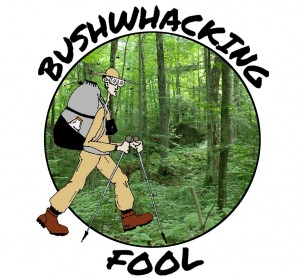
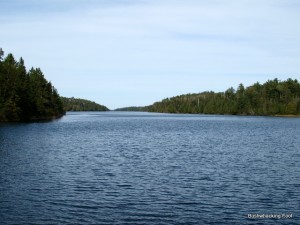
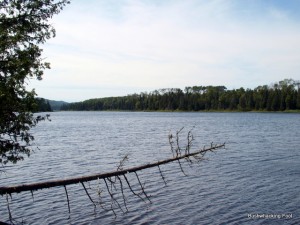
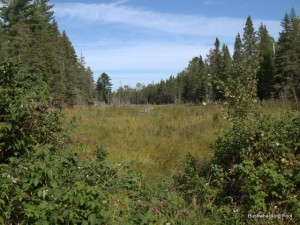
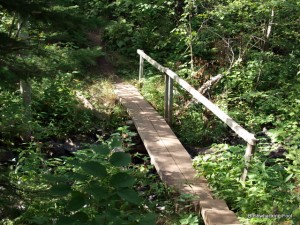
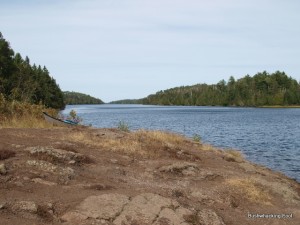
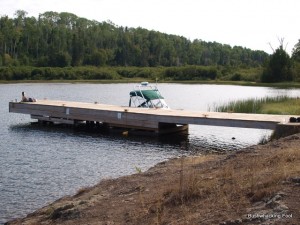
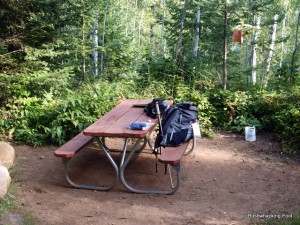
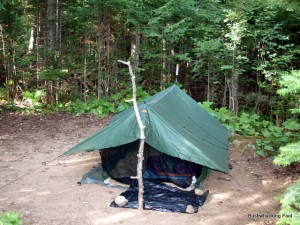
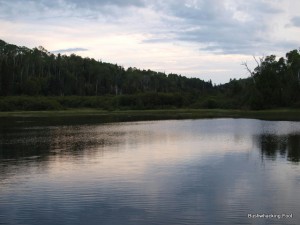
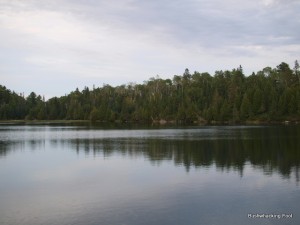
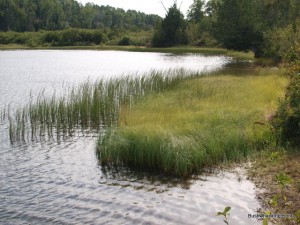



ADKinLA
April 28, 2012 at 8:35 pm
What was the “feeding the animals” policy on the island? Would it have been better to offer up a food offering to the great red squirrel god instead of the stoning method? No judgments at all, just curious.
GREAT recaps of the trip so far, can’t wait for future installments!
bushwhackingfool
April 28, 2012 at 9:14 pm
There is a strict no feeding policy of animals on Isle Royale. This is a pretty common in every place I have ever gone backpacking (which is not that extensive). Typically, if animals are fed then they start assocaiting people with food, which can lead to a plethora of other problems.
Luckily, the rock was small and the squirrel was unharmed. I felt so bad, I never threw another rock at one again during my trip. Although I did continue to mock them by mimicking their calls, which seemed to irritate them much more than my rock throwing.
ADKinLA
April 29, 2012 at 12:45 am
Understood about the policy. And hilarious about the mocking the calls, messing with their heads! 😉
bushwhackingfool
April 29, 2012 at 9:01 am
It seems as if they think I’m a rival squirrel when I mimic their calls. I never thought my calls sounded all that good but obviously it does the trick. On more than one occasion they would act very curious as if they could not figure me out.